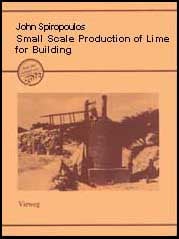
Introduction[edit | edit source]
In many developing countries lime is produced in comparatively large, technically sophisticated limeworks, to supply a specific industry or group of industries, such as chemical or metallurgical works, or sugar refineries. In such cases the limeworks will be situated as close as possible to these factories. Where lime is produced to supply the building industry, the limeworks will probably be situated in, or close to, densely populated areas so that they may absorb as much of the output as possible. Secondary markets will be centres which are sufficiently close to the limeworks to be economical and which can be approached on roads of reasonable condition. Inevitably in such situations areas having a low demand, and which have bad roads leading to them or are a long distance from the limeworks are either left unsupplied or undersupplied at high prices. This often constitutes a large proportion of a developing country.
In these areas productive activities tend to be mainly traditional agriculture, sometimes only just above the subsistence level. Apart from work done in the fields the population is usually unemployed and consequently there is a lack of cash income. The industrial experience of the local population is limited and the technical skills level is low. In addition, it is usually difficult to recruit well trained technicians and managerial staff to work in remote areas and then to keep them there at a cost which can be supported by a small project. The risk of project failure in such areas is usually high. To reduce this, the limeworks must have as small an output as necessary to supply the local demand.
It must be of a low technological level to enable the use of locally available resources. This assists in reducing capital costs to a minimum and also enables operation, and maintenance and repair work to be executed by the local population without the need for highly trained technicians or managerial effort. Further, in most cases it will be desirable to arrange that the most labour intensive methods are used to maximize employment. Care should be taken that employment does not conflict with the existing social organization. For instance working hours may have to be shared with labour in the fields For these reasons small output, Â"low" technology solutions such as those described in this handbook are viewed as appropriate for the situation outlined above. The job of the project planner, in general terms, is to systematically determine the various alternatives in design and methods of operation that could be used, and ascertain the implications of each, whether economic, social or physical. Each aspect of the project must be evaluated by weighing up the technological choices against their implication, and then decisions on each aspect must be viewed in the light of the project as a whole.
Since this type of project is generally of a high risk nature, special efforts must be made in the investigative and planning stage. Information must be collected and the project planned very carefully to minimize the chance of failure. The effect of failure is not only economic, it may also create disillusionment and frustration in the local population which could result in lack of interest in, if not resistance, to further industrial development efforts in the region. The project should be implemented, if possible, with a pilot phase which runs short of a full capital commitment, to test viability before going into full production and a full financial commitment.
The aim of this handbook is to provide a guide to the field worker who is involved in the project investigation, planning and implementation. It provides a set of procedures, technical and operating information, and ideas which, in the experience of the author, may prove to be of value. The handbook is designed to provide a frame of reference and serve as a stimulus for the development of solutions appropriate to the specific circumstances. It must be stressed that what is described in this handbook should not be adopted for use automatically without evaluation.
The handbook has been structured to emphasize the project investigation, planning and implementation aspects, since so much depends on the successful execution of these. Secondarily, technical and operating information is provided, focusing specially on the design, construction and operation of small (less than 15 tonnes per day) lime. works, using a small vertical shaft kiln of the Khadi Village Industries type. These have proved flexible and successful.
A conscious attempt has been made to provide a document which is as general as possible without detracting from its practical value. It is to provide ideas, yet be usable. Finally, a list of names and addresses of organizations which may be of assistance to the project worker has been included.